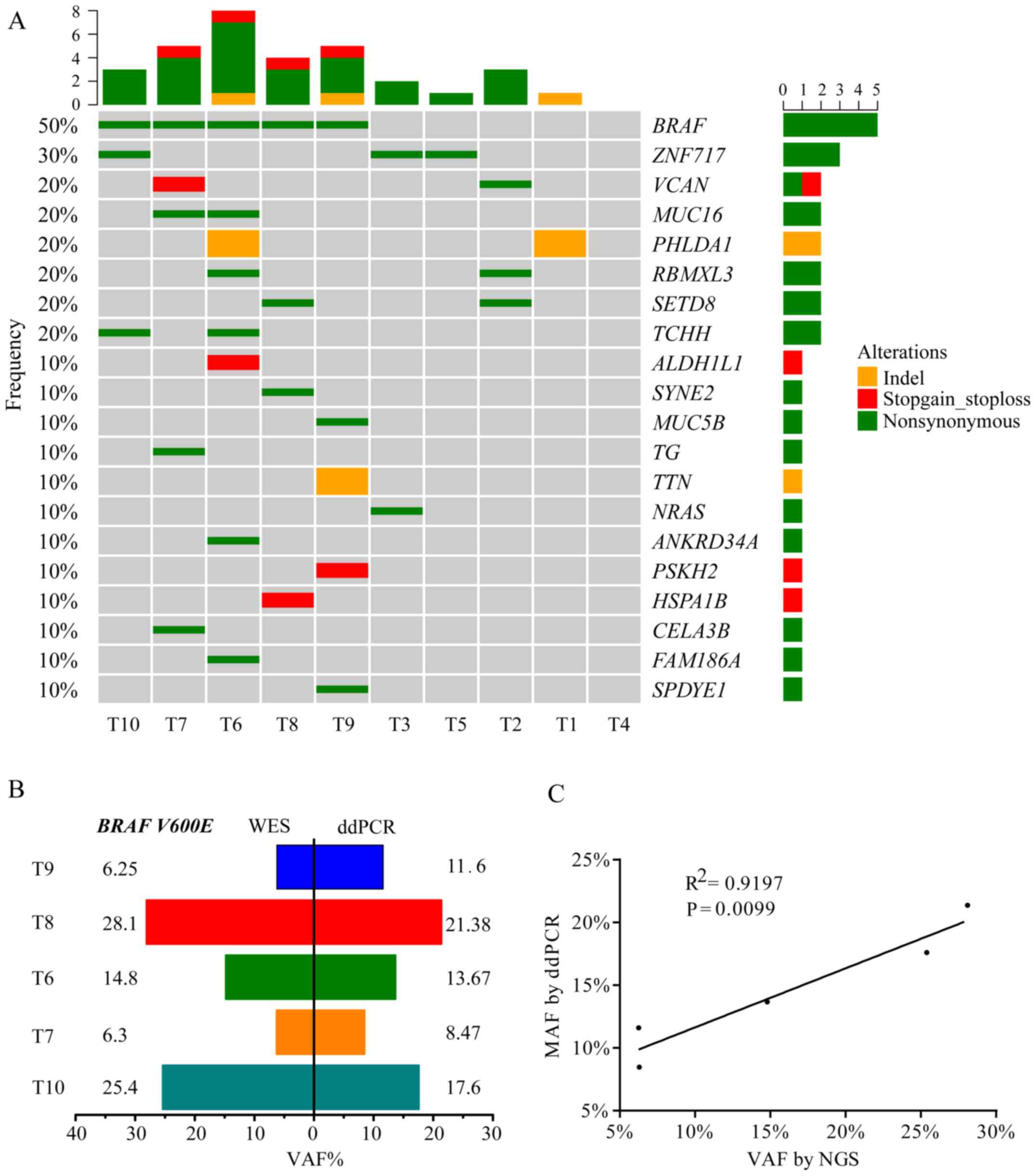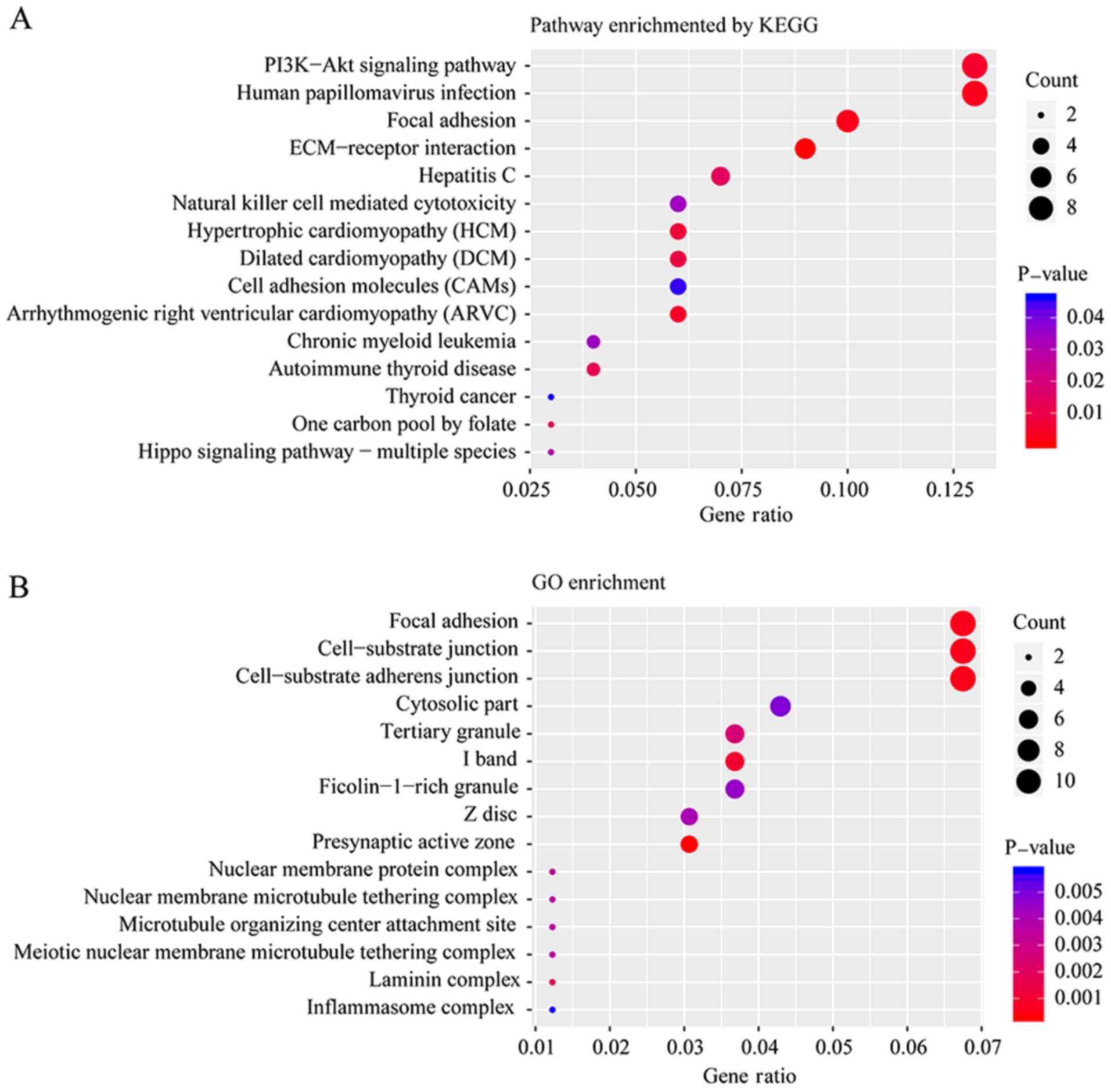|
1
|
Prescott JD and Zeiger MA: The RET
oncogene in papillary thyroid carcinoma. Cancer. 121:2137–2146.
2015. View Article : Google Scholar : PubMed/NCBI
|
|
2
|
Alexander EK, Kennedy GC, Baloch ZW, Cibas
ES, Chudova D, Diggans J, Friedman L, Kloos RT, LiVolsi VA, Mandel
SJ, et al: Preoperative diagnosis of benign thyroid nodules with
indeterminate cytology. N Engl J Med. 367:705–715. 2012. View Article : Google Scholar : PubMed/NCBI
|
|
3
|
Cancer Genome Atlas Research Network, .
Integrated genomic characterization of papillary thyroid carcinoma.
Cell. 159:676–690. 2014. View Article : Google Scholar : PubMed/NCBI
|
|
4
|
Ye L, Zhou X, Huang F, Wang W, Qi Y, Xu H,
Yang S, Shen L, Fei X, Xie J, et al: The genetic landscape of
benign thyroid nodules revealed by whole exome and transcriptome
sequencing. Nat Commun. 8:155332017. View Article : Google Scholar : PubMed/NCBI
|
|
5
|
National Comprehensive Cancer Network
(NCCN), . NCCN Clinical Practice Guidelines in Oncology. Thyroid
Carcinoma (Version 1.2019). https://www.nccn.org/professionals/physician_gls/default.aspx#thyroidMarch
28–2019
|
|
6
|
Burrell RA, McGranahan N, Bartek J and
Swanton C: The causes and consequences of genetic heterogeneity in
cancer evolution. Nature. 501:338–345. 2013. View Article : Google Scholar : PubMed/NCBI
|
|
7
|
Diaz LA Jr and Bardelli A: Liquid
biopsies: Genotyping circulating tumor DNA. J Clin Oncol.
32:579–586. 2014. View Article : Google Scholar : PubMed/NCBI
|
|
8
|
Allin DM, Shaikh R, Carter P, Thway K,
Sharabiani MTA, Gonzales-de-Castro D, O'Leary B, Garcia-Murillas I,
Bhide S, Hubank M, et al: Circulating tumour DNA is a potential
biomarker for disease progression and response to targeted therapy
in advanced thyroid cancer. Eur J Cancer. 103:165–175. 2018.
View Article : Google Scholar : PubMed/NCBI
|
|
9
|
Zane M, Agostini M, Enzo MV, Casal Ide E,
Del Bianco P, Torresan F, Merante Boschin I, Pennelli G, Saccani A,
Rubello D, et al: Circulating cell-free DNA, SLC5A8 and SLC26A4
hypermethylation, BRAF(V600E): A non-invasive tool panel for early
detection of thyroid cancer. Biomed Pharmacother. 67:723–730. 2013.
View Article : Google Scholar : PubMed/NCBI
|
|
10
|
Pupilli C, Pinzani P, Salvianti F, Fibbi
B, Rossi M, Petrone L, Perigli G, De Feo ML, Vezzosi V, Pazzagli M,
et al: Circulating BRAFV600E in the diagnosis and follow-up of
differentiated papillary thyroid carcinoma. J Clin Endocrinol
Metab. 98:3359–3365. 2013. View Article : Google Scholar : PubMed/NCBI
|
|
11
|
Condello V, Macerola E, Ugolini C, De
Napoli L, Romei C, Materazzi G, Elisei R and Basolo F: Analysis of
circulating tumor DNA does not improve the clinical management of
patients with locally advanced and metastatic papillary thyroid
carcinoma. Head Neck. 40:1752–1758. 2018.PubMed/NCBI
|
|
12
|
Lupo M, Guttler R, Geck Z, Tonozzi TR,
Kammesheidt A and Braunstein GD: Is measurement of circulating
tumor DNA of diagnostic use in patients with thyroid nodules?
Endocr Pract. 24:453–459. 2018. View Article : Google Scholar : PubMed/NCBI
|
|
13
|
AJCC Cancer Staging Manual. 8th. Springer;
New York, NY: 2017
|
|
14
|
Li H and Durbin R: Fast and accurate short
read alignment with Burrows-Wheeler transform. Bioinformatics.
25:1754–1760. 2009. View Article : Google Scholar : PubMed/NCBI
|
|
15
|
McKenna A, Hanna M, Banks E, Sivachenko A,
Cibulskis K, Kernytsky A, Garimella K, Altshuler D, Gabriel S, Daly
M and DePristo MA: The Genome Analysis Toolkit: A MapReduce
framework for analyzing next-generation DNA sequencing data. Genome
Res. 20:1297–1303. 2010. View Article : Google Scholar : PubMed/NCBI
|
|
16
|
Cibulskis K, Lawrence MS, Carter SL,
Sivachenko A, Jaffe D, Sougnez C, Gabriel S, Meyerson M, Lander ES
and Getz G: Sensitive detection of somatic point mutations in
impure and heterogeneous cancer samples. Nat Biotechnol.
31:213–219. 2013. View
Article : Google Scholar : PubMed/NCBI
|
|
17
|
Yu G, Wang LG, Han Y and He QY:
ClusterProfiler: An R package for comparing biological themes among
gene clusters. OMICS. 16:284–287. 2012. View Article : Google Scholar : PubMed/NCBI
|
|
18
|
R Core Team: R, . A language and
environment for statistical computing. R Foundation for Statistical
Computing; Vienna, Austria: 2018, https://www.R-project.org
|
|
19
|
Gu Z, Eils R and Schlesner M: Complex
heatmaps reveal patterns and correlations in multidimensional
genomic data. Bioinformatics. 32:2847–2849. 2016. View Article : Google Scholar : PubMed/NCBI
|
|
20
|
Xing M, Alzahrani AS, Carson KA, Shong YK,
Kim TY, Viola D, Elisei R, Bendlová B, Yip L, Mian C, et al:
Association between BRAF V600E mutation and recurrence of papillary
thyroid cancer. J Clin Oncol. 33:42–50. 2015. View Article : Google Scholar : PubMed/NCBI
|
|
21
|
Kim TH, Park YJ, Lim JA, Ahn HY, Lee EK,
Lee YJ, Kim KW, Hahn SK, Youn YK, Kim KH, et al: The association of
the BRAF(V600E) mutation with prognostic factors and poor clinical
outcome in papillary thyroid cancer: A meta-analysis. Cancer.
118:1764–1773. 2012. View Article : Google Scholar : PubMed/NCBI
|
|
22
|
Kim BH, Kim IJ, Lee BJ, Lee JC, Kim IS,
Kim SJ, Kim WJ, Jeon YK, Kim SS and Kim YK: Detection of plasma
BRAF(V600) mutation is associated with lung metastasis in papillary
thyroid carcinomas. Yonsei Med J. 56:634–640. 2015. View Article : Google Scholar : PubMed/NCBI
|
|
23
|
Paluch EK, Aspalter IM and Sixt M: Focal
adhesion-independent cell migration. Annu Rev Cell Dev Biol.
32:469–490. 2016. View Article : Google Scholar : PubMed/NCBI
|
|
24
|
Cibas ES and Ali SZ: The 2017 Bethesda
system for reporting thyroid cytopathology. Thyroid. 27:1341–1346.
2017. View Article : Google Scholar : PubMed/NCBI
|
|
25
|
Haugen BR, Alexander EK, Bible KC, Doherty
GM, Mandel SJ, Nikiforov YE, Pacini F, Randolph GW, Sawka AM,
Schlumberger M, et al: 2015 American thyroid association management
guidelines for adult patients with thyroid nodules and
differentiated thyroid cancer: The American thyroid association
guidelines task force on thyroid nodules and differentiated thyroid
cancer. Thyroid. 26:1–133. 2016. View Article : Google Scholar : PubMed/NCBI
|
|
26
|
Xing M, Alzahrani AS, Carson KA, Viola D,
Elisei R, Bendlova B, Yip L, Mian C, Vianello F, Tuttle RM, et al:
Association between BRAF V600E mutation and mortality in patients
with papillary thyroid cancer. JAMA. 309:1493–1501. 2013.
View Article : Google Scholar : PubMed/NCBI
|
|
27
|
Lin KL ZX and Dai XX: Detection of BRAF
gene mutations in patients with high risk papillary thyroid
carcinoma before the operation. Chin J Oncol. 33:130–131. 2011.
|
|
28
|
Prescott JD, Sadow PM, Hodin RA, Le LP,
Gaz RD, Randolph GW, Stephen AE, Parangi S, Daniels GH and Lubitz
CC: BRAFV600E status adds incremental value to current
risk classification systems in predicting papillary thyroid
carcinoma recurrence. Surgery. 152:984–990. 2012. View Article : Google Scholar : PubMed/NCBI
|
|
29
|
Riesco-Eizaguirre G, Gutiérrez-Martínez P,
García-Cabezas MA, Nistal M and Santisteban P: The oncogene BRAF
V600E is associated with a high risk of recurrence and less
differentiated papillary thyroid carcinoma due to the impairment of
Na+/I- targeting to the membrane. Endocr Relat Cancer. 13:257–269.
2006. View Article : Google Scholar : PubMed/NCBI
|
|
30
|
Muzny DM, Scherer SE, Kaul R, Wang J, Yu
J, Sudbrak R, Buhay CJ, Chen R, Cree A, Ding Y, et al: The DNA
sequence, annotation and analysis of human chromosome 3. Nature.
440:1194–1198. 2006. View Article : Google Scholar : PubMed/NCBI
|
|
31
|
Duan M, Hao J, Cui S, Worthley DL, Zhang
S, Wang Z, Shi J, Liu L, Wang X, Ke A, et al: Diverse modes of
clonal evolution in HBV-related hepatocellular carcinoma revealed
by single-cell genome sequencing. Cell Res. 28:359–373. 2018.
View Article : Google Scholar : PubMed/NCBI
|
|
32
|
Fiala C and Diamandis EP: Utility of
circulating tumor DNA in cancer diagnostics with emphasis on early
detection. BMC Med. 16:1662018. View Article : Google Scholar : PubMed/NCBI
|
|
33
|
Mengual L, Lozano JJ, Ingelmo-Torres M,
Gazquez C, Ribal MJ and Alcaraz A: Using microRNA profiling in
urine samples to develop a non-invasive test for bladder cancer.
Int J Cancer. 133:2631–2641. 2013.PubMed/NCBI
|
|
34
|
Bettegowda C, Sausen M, Leary RJ, Kinde I,
Wang Y, Agrawal N, Bartlett BR, Wang H, Luber B, Alani RM, et al:
Detection of circulating tumor DNA in early- and late-stage human
malignancies. Sci Transl Med. 6:224ra242014. View Article : Google Scholar : PubMed/NCBI
|
|
35
|
Ye Q, Ling S, Zheng S and Xu X: Liquid
biopsy in hepatocellular carcinoma: Circulating tumor cells and
circulating tumor DNA. Mol Cancer. 18:1142019. View Article : Google Scholar : PubMed/NCBI
|
|
36
|
Garlan F, Laurent-Puig P, Sefrioui D,
Siauve N, Didelot A, Sarafan-Vasseur N, Michel P, Perkins G, Mulot
C, Blons H, et al: Early evaluation of circulating tumor DNA as
marker of therapeutic efficacy in metastatic colorectal cancer
patients (PLACOL study). Clin Cancer Res. 23:5416–5425. 2017.
View Article : Google Scholar : PubMed/NCBI
|
|
37
|
Tan L, Sandhu S, Lee RJ, Li J, Callahan J,
Ftouni S, Dhomen N, Middlehurst P, Wallace A, Raleigh J, et al:
Prediction and monitoring of relapse in stage III melanoma using
circulating tumor DNA. Ann Oncol. 30:804–814. 2019. View Article : Google Scholar : PubMed/NCBI
|
|
38
|
Cradic KW, Milosevic D, Rosenberg AM,
Erickson LA, McIver B and Grebe SK: Mutant BRAF(T1799A) can be
detected in the blood of papillary thyroid carcinoma patients and
correlates with disease status. J Clin Endocrinol Metab.
94:5001–5009. 2009. View Article : Google Scholar : PubMed/NCBI
|
|
39
|
Khier S and Lohan L: Kinetics of
circulating cell-free DNA for biomedical applications: Critical
appraisal of the literature. Future Sci OA. 4:FSO2952018.
View Article : Google Scholar : PubMed/NCBI
|

















